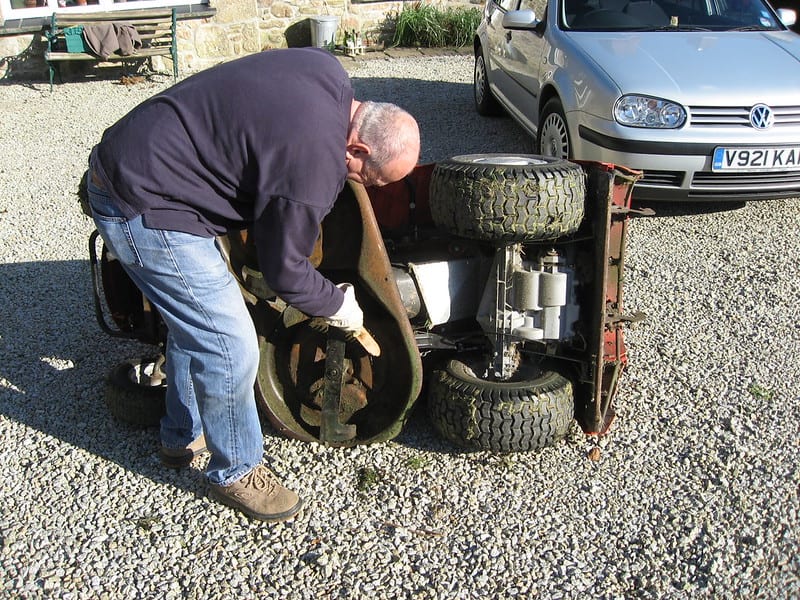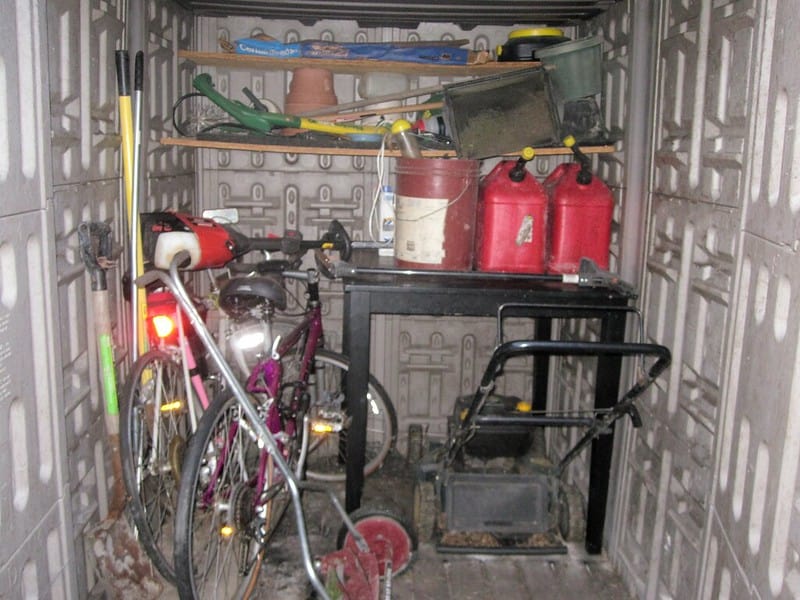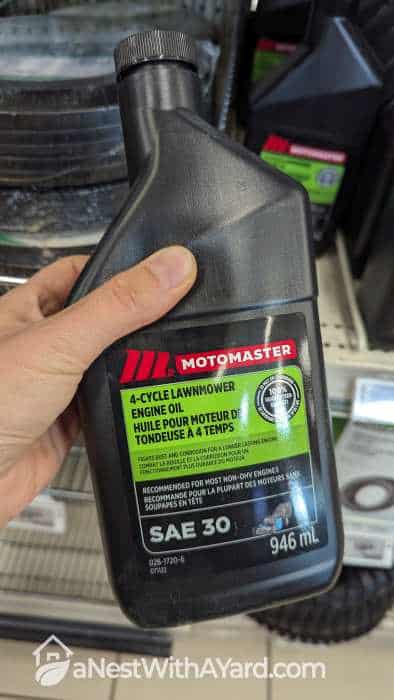To winterize your lawn mower, you first have to drain the old fuel from the gas tank and clean the deck. Check your owner’s manual to see if you need to add new fuel and fuel stabilizer, or not. After that, you can prep the mower for storage by changing the oil, air filter, and spark plugs.
It’s time to put your lawn mower into hibernation. So, how do you winterize your mower to ensure it is in top shape for your first spring-season lawn haircut?
I’ve researched this subject to save you the trouble and potential repair expenses, so stay tuned! You’ll learn how to winterize both gas and battery-powered mowers and get them ready for the first mow of the year.
Contents
The Best Lawn Mower Maintenance At The End Of The Season: Step By Step Instructions
Are you ready? Let’s go through all the necessary steps of preparing your mower for the next mowing season!
Remove The Fuel From The Gas Tank
I once left fuel in my riding mower until the spring – it clogged the fuel line and corroded the carburetor, leading to a pricey repair. So, take my advice: Always empty the remaining gas from your mower’s fuel system before you store it for a long time. Here’s how to do it:
Empty The Tank
Harrison Kral from Family Handyman magazine gives us a step-by-step guide to emptying the fuel tank:
- Take the fuel tank cap off and tip your walk-behind mower over a drain pan. If you have a riding mower like me, use a hose to siphon off the gas from fuel lines.
- Locate the drain valve/bolt on the carburetor bowl. Remove it to drain the old gas into a container.
If the carburetor on your mower doesn’t have a drain valve/bolt, run its engine until it stalls. Next, restart the engine a few times until it won’t start anymore – that’s a sign all the fuel is gone.
- Take the old gasoline to a local recycling facility.
Kral goes on to explain that some manufacturers recommend storing lawn mowers with a full tank of stabilized fuel. If that’s in your owner’s manual, follow the procedure below.
Add Fuel Stabilizer
- Add fuel stabilizer to an empty gas can.
- Go to the nearest gas pump and fill this can with fresh gas.
- Mix the fuel and the stabilizer well.
- Fill your mower tank with this mixture and screw on the gas cap.
- Run the mower for 10 minutes to fill the carburetor bowl with stabilized gas.
- Top off the gas tank.
Clean The Mowing Deck

As Tobie Stanger from the Consumer Reports organization explains, cleaning the mowing deck is a crucial step in winterizing your lawn mower. I clean the deck of my riding mower throughout the season, but it’s far more important to do it before putting the mower away for the winter since any left-on moisture or grass clippings can damage it. The photo above is courtesy of Kai Hendry.
In the article I read in the Spruce Magazine, landscaping expert David Beaulieu lists all the steps you need to take to clean your lawn mower’s deck:
- Disconnect the spark plug wire or remove the battery on battery-powered models. This is an important safety measure, so please don’t skip this step! I also recommend wearing heavy work gloves to protect your hands from the blade.
- Position the lawn mower on its side. Ensure the air filter is facing up if you have a gas mower.
- Use your garden hose to wash the deck thoroughly. I use my pressure washer instead of the garden hose since it is much more efficient!
- Use a wire brush, some hot water, and soap to scrub off debris, ensuring all the dirt and grass clippings are removed from the mower blade.
- Rinse the mower deck.
- Dry the deck with a cloth. I leave it to air dry for a couple of hours, too.
- Spray some vegetable oil or silicone spray onto the deck to prevent future grass and dirt buildup.
Why Is Cleaning The Deck So Important?
Professionals from Koenig Equipment say cleaning the deck:
- boosts the performance of your mower
- prevents the spread of lawn diseases.
They recommend doing it at least twice a year. If you are still not sure if you can manage it, watch this video I found:
Prepare The Lawn Mower For Storage

Once you clean your mower, it’s time to prep it for its winter slumber. Here are the necessary steps: The photo above is courtesy of Tony Alter.
Change The Oil

The already-mentioned Harrison Kral from Family Handyman magazine explains that old oil contains traces of gasoline and some moisture and soot that might corrode the internal engine components during the winter. So, once you change the oil, run your mower for a couple of minutes to coat all the internal parts with clean oil. Don’t forget to recycle the old oil at a service station!
My advice is to ensure you purchase the right type of oil for your mower. Check your user manual or contact the manufacturer.
Change The Air Filter
After the oil change, it is time to change the air filter. Scott Schilling, editorial assistant of This Old House Magazine, warns that a dirty air filter can block air and prevent the mower’s engine from efficiently burning gas. So, how to replace the air filter? Here is what Schilling suggests:
Paper Filter
All you need to do is remove the filter and replace it with a new one, making sure that the paper edges face out.
Oil-Soaked Sponge Filter
Remove the filter and then wash it thoroughly with some soapy water. Once it is completely dry, pour some clean oil on it and put it back.
Check The Fuel Filter

As I learned from the article I read in the Family Handyman magazine, some mowers have a fuel filter. It might be a good idea to inspect it when preparing your mower for winter storage. Check your owner’s manual to see where this filter is, and then take it off and hold it up to the light to see if it is dirty or clogged. If yes, replace it with a new one. The photo above is courtesy of Jim Handcock.
Replace The Spark Plug
Experts from MTD Products, one of the leaders in outdoor power equipment, think that replacing the spark plugs is as important as replacing the air filters and keeping the oil tank in tip-top condition. If your spark plug is damaged or worn out, it can decrease fuel efficiency and power, and increase carbon build-up.
I replace my spark plug every year, even if it’s seemingly in good condition. It costs only a few dollars but guarantees you won’t have any problems when starting your mower in the spring.
Safely Store The Mower

Congratulations! Just find a safe place for your lawn mower, and you’re done! Experts from Briggs & Stratton advise storing your mower in a protected, well-ventilated area, away from a furnace, water heater, or any appliances with a pilot light. The photo above is courtesy of Doug McCaughan.
I keep mine in a garden shed with my lawn equipment. If you have a walk-behind mower, you can store it in any dry location – even your basement or attic.
FAQs
Should you leave gas in lawn mower over winter?
You should not leave gas in a lawn mower over winter. It can become stale, clog up the fuel hoses, and corrode the carburetor.
What should I do to winterize my lawn mower?
You should empty the fuel tank, clean the deck, and change the spark plug, oil, air filter, and fuel filter (if your model has one).
Should I leave oil in my lawn mower over winter?
You should not leave oil in your lawn mower over winter because it contains traces of gasoline, moisture, soot, and acids that can corrode internal parts of the engine.
Final Checklist
Did you find my instructions easy to follow? Leave your questions and comments, and share this article!
In short, to winterize your mower, you should:
- Remove the old fuel.
- Clean the deck.
- Prepare it for storage by replacing the spark plug, oil, and air/fuel filters.
- Store it in a safe & dry place.
